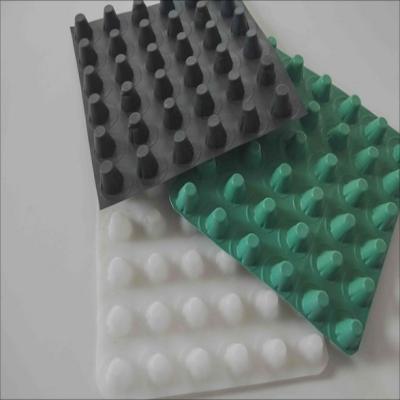Drainage plate It has very good drainage performance, corrosion resistance, pressure resistance and environmental protection characteristics. It is commonly used in building foundation engineering, basement waterproofing, roof greening, highway and railway tunnel drainage and other fields.
1. Raw material selection
The main raw material of drainage board is high-density polyethylene ( HDPE)、 Polypropylene ( PP) Equal high-strength plastics. These materials have very good corrosion resistance, weather resistance and pressure resistance, and can meet the needs of use in different environments. When selecting raw materials, it is necessary to strictly control the quality of raw materials and ensure that the materials meet the production standards, so as to ensure the final performance of the drainage board.
2. Production process flow
The production process of drainage board mainly includes steps such as batching, stirring, extrusion, calendering (or mold forming), cooling, cutting, inspection and packaging.
1、Ingredients: According to the production demand, raw materials such as polymer, reinforcing fiber and filler are mixed according to a certain proportion. In this step, the ratio of raw materials must be strictly controlled to ensure the performance and quality of the drainage board.
2、Mixing: Put the mixed raw materials in a blender and mix thoroughly so that the components are evenly distributed. During the stirring process, attention should be paid to the stirring speed and stirring time to ensure that the raw materials are fully mixed.
3、Extrusion: The stirred material is extruded through an extruder to form a certain shape of a drainage plate embryo. During the extrusion process, the extrusion speed and temperature should be controlled to ensure the quality and shape of the embryo body.
4、Calendering (or die molding): The extruded embryo body is calendered through a calender or molded through a die to make it have a certain thickness and flatness. This process requires controlling the calendering pressure, temperature and die design to ensure the compactness and dimensional accuracy of the embryo body.
5、Cooling: Cooling the calendered (or molded) embryo body to make it achieve a certain hardness and stability. During the cooling process, attention should be paid to the cooling speed and temperature to avoid deformation or cracking of the embryo body.
6、Cutting: Cutting the cooled embryo body according to a certain size to form the finished product of the drainage board. During the cutting process, the cutting accuracy and speed must be ensured to ensure the size and quality of the drainage board.
7、Inspection and packaging: Carry out quality inspection on the cut drainage board, including appearance quality, dimensional accuracy, physical properties, etc. After passing the inspection, it will be packaged again, usually wrapped in plastic film, and properly marked and packaged.
3. Quality control and future development trends
During the production process of drainage board, quality control is the key to ensure product performance. Raw materials should be strictly screened and inspected, and the production process should be strictly controlled to ensure that every step is carried out according to the prescribed operation. Also perform quality inspection on the finished product to ensure that it meets relevant standards and requirements.
Post time: Jan-18-2025




